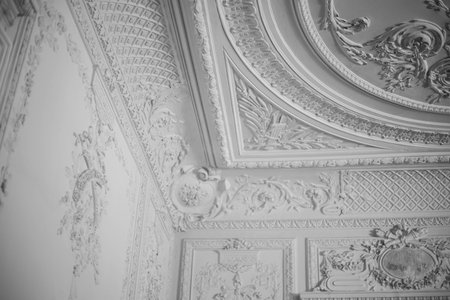Introduction to Architectural Details in British Homes
When wandering through the classic terraced houses of London or the stately townhouses of Edinburgh, it’s hard not to notice the intricate architectural details that define the character of British homes. Features like cornices and dado rails are far more than decorative flourishes; they are hallmarks of period architecture that reflect centuries of craftsmanship and design evolution. In the UK, such features hold particular significance, echoing Georgian, Victorian, and Edwardian sensibilities where attention to interior detail was considered a measure of taste and status. Cornices—those ornate mouldings at the junction between wall and ceiling—and dado rails—horizontal bands that once protected walls from scuffs—are rooted in a historical context that values both function and form. Today, these elements continue to be treasured for their ability to add depth, texture, and a sense of heritage to modern living spaces. By appreciating these period features, homeowners connect with the rich architectural narrative woven into Britain’s built environment.
2. Cornices: Tradition and Transformation
Cornices have long played a pivotal role in British interiors, acting as a decorative transition between the wall and ceiling. Rooted in classical architecture, these moulded projections were originally inspired by Greek and Roman design, lending an air of elegance and proportion to both stately homes and modest terraces. In the UK, cornices became especially prominent during the Georgian and Victorian eras, symbolising craftsmanship and attention to detail.
In todays British homes, cornices are no longer confined to traditional settings. While many homeowners choose to restore or replicate period features, contemporary interpretations are becoming increasingly popular. By pairing classic forms with modern accent paints, you can highlight the intricate details of cornices and create striking visual contrasts. This approach works particularly well in spaces where you wish to celebrate architectural heritage while embracing a more current aesthetic.
| Cornice Style | Period Origin | Contemporary Paint Ideas |
|---|---|---|
| Egg-and-Dart | Georgian/Regency | Matte charcoal or deep navy for dramatic contrast |
| Dentil Moulding | Victorian/Edwardian | Satin white with pastel highlights for subtle emphasis |
| Simplified Cove | Modern/Minimalist | Soft greys or bold accent colours to define lines |
Top Tip: When selecting accent paint for cornices, consider the existing palette of your room. In period properties, muted heritage tones tend to enhance authenticity, while contemporary spaces benefit from bolder contrasts or unexpected pops of colour. Whichever route you choose, painting cornices is a low-commitment yet high-impact way to transform a space without compromising its British character.

3. Dado Rails: Practical Elegance
Dado rails, sometimes referred to as chair rails, have long been a defining feature within British interiors, seamlessly blending practicality with understated style. Originally conceived to protect walls from scuffs and scrapes caused by furniture, these horizontal mouldings have evolved into an essential architectural detail in both period homes and contemporary spaces across the UK.
In traditional British properties, dado rails are often found at approximately 1 metre from the floor, visually dividing the wall and providing a sense of proportion that complements classic Georgian or Victorian room layouts. In such settings, it’s common to see richer, deeper paint colours or decorative wallpaper below the rail—sometimes finished with robust wainscoting or panelling—and lighter, airier hues above. This approach not only draws the eye upward but also enhances the feeling of height and openness.
Modern interpretations of dado rails in new-builds or renovated spaces tend to focus on minimalism and subtlety. Here, homeowners might opt for a low-profile rail painted in the same colour as the wall for a barely-there effect, or use contrasting shades above and below to introduce visual intrigue without overwhelming the room. For example, pairing a soft sage green beneath the rail with a crisp off-white above can create a distinctly British palette that feels fresh yet rooted in heritage.
When considering colour placement for dado rails, it’s important to take into account both natural light levels and ceiling height. Darker tones below the rail can ground a space and conceal daily wear, while paler shades above reflect light and keep things feeling bright. In smaller rooms or hallways—a common feature in UK homes—choosing harmonious colours that gently contrast can prevent the space from feeling cramped.
Ultimately, whether you’re restoring a listed townhouse in Bath or updating a modern London flat, integrating dado rails offers an opportunity to add subtle character while enhancing durability. Don’t be afraid to experiment: try pairing your rail with accent paints that echo tones from soft furnishings or artwork for a cohesive British look that balances tradition with contemporary flair.
4. Choosing the Right Accent Paint
Selecting the perfect accent paint is pivotal when highlighting architectural details such as cornices and dado rails within UK homes. The right paint not only draws attention to these features but also harmonises with the broader character of traditional British interiors. Below, we explore how to make informed choices, referencing trusted British paint brands and current trends.
Understanding Architectural Character
Victorian, Edwardian, and Georgian homes typically feature ornate mouldings, intricate cornices, and pronounced dado rails. These elements offer an opportunity to introduce subtle contrast or bold statements through colour. For instance, pairing a crisp white cornice with a muted wall colour can evoke classic restraint, while a deep-toned dado rail might provide contemporary drama.
Recommended Paint Tones by Feature
| Architectural Detail | Traditional Tone | Contemporary Trend | Suggested Brands |
|---|---|---|---|
| Cornices | Chalky Whites (e.g., Dulux ‘Timeless’) |
Pale Greys (e.g., Little Greene ‘French Grey’) |
Dulux, Little Greene, Crown |
| Dado Rails | Deep Greens (e.g., Farrow & Ball ‘Calke Green’) |
Muted Blues (e.g., Craig & Rose ‘Harris Blue’) |
Farrow & Ball, Craig & Rose |
| Wall Panels/Accents | Rich Creams (e.g., Crown ‘Soft Linen’) |
Bold Ochres (e.g., Farrow & Ball ‘India Yellow’) |
Crown, Farrow & Ball |
Current British Colour Trends
The UK market is currently seeing a resurgence in heritage shades—think sage greens, dusty blues, and soft clays—which nod to period authenticity while remaining versatile for modern living. Brands like Farrow & Ball and Little Greene lead in offering historically inspired palettes with environmentally conscious formulations.
Tips for Cohesive Detailing
- Test Samples: Always patch-test chosen shades alongside existing woodwork and furnishings under different lighting conditions.
- Finish Matters: Opt for eggshell or satinwood finishes for trim work; they’re durable and subtly reflective.
- Tonal Consistency: Aim for tonal families across walls and detailing for a sophisticated yet understated result.
- Bespoke Mixing: Many UK paint specialists offer custom colour matching if you wish to replicate or complement original period tones.
A Note on Sustainability
Increasingly, homeowners are seeking low-VOC and eco-friendly paints. Leading British brands now offer sustainable options without compromising depth of colour or finish quality—a practical consideration for both health and heritage preservation.
5. Application Tips: Painting with Precision
Step-by-Step Advice for Impeccable Detailing
When it comes to elevating the character of your home through cornices and dado rails, precision in painting is essential. Achieving that crisp, quintessentially British look demands thoughtful preparation and the right approach. Here’s a practical guide to help you make the most of your architectural features.
Preparation: The Foundation of a Flawless Finish
Begin by ensuring all surfaces are clean, dry, and free from dust or grease. Use a mild sugar soap solution to wash down cornices and dado rails, then lightly sand them with fine-grit sandpaper to create a key for the new paint. Fill any cracks or imperfections with decorator’s caulk or wood filler, smoothing over with a putty knife. Once dry, sand again for a seamless surface. Mask adjacent walls and ceilings using low-tack painter’s tape—this extra step is crucial for those sharp lines so beloved in British interiors.
Choosing the Right Tools
Select high-quality brushes with angled bristles—ideally 1-inch or 1.5-inch sizes—for maximum control along mouldings and edges. For longer runs of dado rail, a small foam roller can provide an even finish. Keep a damp cloth at hand to quickly correct any stray marks before they dry.
Applying the Paint: Techniques for Clean Lines
Start by ‘cutting in’ along the edge of the cornice or dado rail with your angled brush, working slowly and steadily. Apply paint sparingly at first; it’s easier to add another coat than to rectify drips or overspill. For intricate detailing on plaster cornices, use a fine artist’s brush to highlight reliefs or patterns with accent colours—this nods to classic British period homes. Allow each coat to dry thoroughly as per manufacturer instructions before applying the next.
Finishing Touches: The British Standard
Once the final coat is dry, carefully remove masking tape at a 45-degree angle to avoid lifting fresh paint. Inspect your work in natural light, touching up any areas as needed for a truly professional appearance. Remember, patience and attention to detail are the hallmarks of British decorating tradition—take your time for results that will stand proud for years to come.
6. Blending Heritage with Modernity
Striking the right balance between honouring a propertys architectural heritage and introducing contemporary elements is both an art and a technical challenge. For British homes—whether a Georgian terrace in Bath or a Victorian semi in Manchester—preserving features such as cornices and dado rails is often at the heart of maintaining period character. Yet, injecting modern flair can invigorate these spaces, ensuring they feel fresh and relevant for todays lifestyles.
Respecting Original Features
The starting point is always respect for original detailing. Where possible, retain and restore existing cornices and dado rails rather than replacing them. Gentle cleaning, careful repairs using traditional materials (like plaster or timber), and sympathetic paint finishes will preserve their integrity. If elements are missing or beyond repair, sourcing authentic profiles from specialist suppliers ensures continuity with the past.
Contemporary Colour Schemes
Modernising doesnt have to mean erasing history. Instead, use accent paint to highlight mouldings and rails in unexpected hues—think charcoal greys or deep blues against crisp white walls. This approach pays homage to period craftsmanship while adding a bold, contemporary twist. In open-plan layouts, accent paint on cornices can subtly define zones without erecting physical barriers.
Mixing Old with New Materials
Integrating modern materials—such as matte-finish paints or eco-friendly stains—can refresh classic features. Pairing ornate plasterwork with sleek lighting or minimalist furnishings creates a dialogue between eras. The juxtaposition neednt be jarring; instead, it provides visual interest and celebrates both heritage and innovation.
Layered Detailing for Depth
Layering details is another effective strategy: combine restored dado rails with modern panelling below or introduce graphic wallpapers above. This technique nods to traditional British decorating conventions while allowing personal expression through colour and texture choices.
A Thoughtful Approach
The most successful interiors are those that neither freeze in time nor disregard their roots. By carefully blending restoration with reinvention—through considered use of paint, materials, and detailing—homeowners can achieve interiors that feel both timelessly British and distinctly current.


